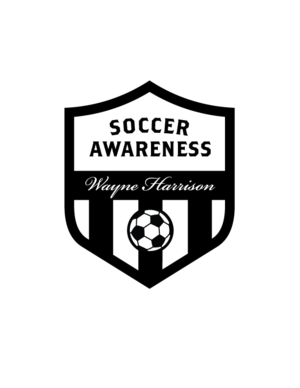Pressing in the Attacking Third - Training Center Exclusive
/Defending in the Attacking Third
Start Position 1 - (6)’s pass is too heavy and it goes behind defender (3), attacking (8) and (7) close down and show inside, (9) pushes on to cover the back pass to the keeper.
All players take their positions of support off the FIRST pressing player.
First pressing player MUST get the angle of approach correct
Immediate pressing player (7) MUST press correctly. Often the first pressing player allows the defender to escape too easily by pressing at the wrong angle.
It is a small distance to make the pressing angle mistake but a big difference in winning the ball back or not. Here defender (3) can clear the ball wide even kick it out of play to give his or her team time to get reorganized as shown.
Showing INSIDE to our strongest pressure
Defender (3) May get turned or end up facing back, either way show inside.
Pressurizing player (7) forces the player on the ball inside towards the support players not outside. Inside means if we gain possession it’s a short route to get a cross or shot on goal. Show outside and if the defending team are under pressure the player on the ball can kick it out of play and give them time to reorganize plus there is no chance of an immediate cross or shot if we win it back in a very wide area.
(8) and (7) close down show inside, (9) closes the keeper to prevent the back pass, (2) (11), (8) and (6) close spaces down close to the ball, (3), (5) and (4) push up but still leave distance from the opponent strikers in case the ball can be played in behind them. Organization – Work with pressing player, support player, then cover players, then defenders and keeper (individual, unit, and team).
First pressing player MUST get the angle of approach correct: Pressing outside
Not as good as pressing to force inside but (2) could regain possession (by positioning to suit (7)’s new pressing position) based on a bad pass by defender (3) or if (3) does kick the ball out of play we get a set play at least.
(9) Can’t get across quickly enough to force (3) inside so has to force (3) outside. The rest of the team can adjust across also to condense the spaces down the side of the field to help win back the ball. Players furthest away from the ball are aware of their immediate opponent but mark spaces rather than players. For example (11) moves across the field and leaves opponents defender (2) alone because (9)‘s position prevents defender (3) from being able to pass to defender (2).
Players mark in advance of their opponents, filling in the spaces where the ball is likely to be played into (example 2’s positioning).
How to position and regain possession from the long kick by our keeper
As a last resort we must kick the ball long as opponents prevent us building out the back.
We can turn this into an advantage but the correct positioning of the players around where the ball is going must be addressed.
Have a pre-conceived player to kick the ball too (our best header up front).
Position all around the receiving player and try to outnumber the opposition in the immediate area.
Teams often think as they have possession of the ball through the keeper they must spread out but in this case it is the opposite which should happen and they must condense around where the ball is being delivered
We try to play out the back but are pressed to prevent it
This can still be EFFECTIVE: Now we condense as a team “short and tight”. Our (10) is good in the air so we hit him and we have a lot of players around him to win the 2nd ball. Of course opponents will readjust also. Its cat and mouse.
How NOT to set up to win the second ball
Our team is spread out and not in positions to win back the ball immediately. We must press upwards the half way line first. Team most likely to win the second ball in this set up are the opponents.
How we should set up to have the best chance to regain possession
This can still be EFFECTIVE: Now we condense as a team “short and tight”. Our (10) is good in the air so we hit him and we have a lot of players around him to win the 2nd ball. Of course opponents will readjust also. Its cat and mouse.
We leave their 3 strikers offside
Players can gamble for the flick on from (10). Players position behind, in front and alongside (10) so wherever the 2nd ball goes we have players to pick it up. WE ABSOLUTELY MUST get better at this. Obviously opponents will position better than this defensively; but you get the point.
Opponents win the header but we are positioned well to win the second ball even though they won it first
Opponents win the first ball with a header clear. We are positioned so as to be able to win the next ball.




















